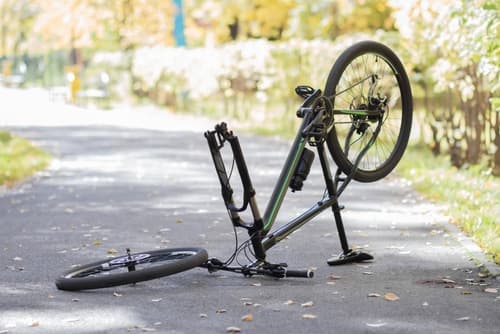If a driver hits you while you are riding your bicycle, filing a lawsuit may be necessary to seek compensation for your injuries. A skilled Ontario bicycle accident lawyer can handle the entire legal process for you, starting with investigating the accident and gathering evidence such as police reports, medical records, and witness testimony. They will assess the extent of your injuries and work to prove the driver’s negligence, whether it is due to distracted driving, speeding, or failing to yield the right-of-way.
Your lawyer will also negotiate with insurance companies to seek a fair settlement, and if needed, they will take the case to trial. With their experience, they ensure you receive the compensation you deserve for medical expenses, lost income, and pain and suffering.
How Do Negligent Drivers Cause Bicycle Accidents?

Negligent drivers are a leading cause of bicycle accidents, often leading to serious injuries or fatalities for cyclists. Many of these accidents result from a lack of attention, recklessness, or failure to follow traffic laws.
One of the most frequent causes of bicycle accidents is distracted driving. Drivers who text, talk on the phone, or engage with in-car entertainment systems often fail to notice cyclists on the road. When a driver’s attention is diverted from the road, they may not see a cyclist approaching an intersection or riding alongside their vehicle, increasing the risk of a collision.
Another common cause of bicycle accidents is failure to yield the right-of-way. Drivers who fail to yield at intersections or when making turns often cause accidents by cutting off cyclists or failing to see them as they pass. A driver turning left or right may not notice an oncoming cyclist, especially if the driver is not paying attention to the surroundings or fails to check their blind spots.
In addition, speeding is a significant factor in bicycle accidents. Drivers who speed reduce their reaction time and may be unable to stop in time to avoid hitting a cyclist. Additionally, higher speeds increase the severity of injuries in the event of a collision, making the outcome of the accident more dangerous for the cyclist.
Running red lights or stop signs is another common way that negligent drivers cause bicycle accidents. Some drivers attempt to beat a light or fail to stop at a stop sign, putting cyclists at risk. Since cyclists are more vulnerable in these situations, they may not have enough time to react, leading to collisions that can otherwise be avoided.
Reckless lane changes also contribute to accidents involving bicycles. Drivers who change lanes without signaling or checking their mirrors often move into the path of a cyclist, causing accidents. This is especially dangerous when the cyclist is riding in a bike lane, as they may not expect a vehicle to invade that space.
Finally, driving under the influence of alcohol or drugs is a leading cause of bicycle accidents. Impaired drivers have reduced coordination, slowed reflexes, and poor judgment, all of which make it more likely that they will cause an accident with a cyclist.
What Are the Most Common Bike Accident Injuries?

Bicycle accidents can lead to a variety of injuries, some of which can be severe and life-threatening. Cyclists are particularly vulnerable because they have little protection compared to motorists. The most common types of bike accident injuries include head injuries, fractures, road rash, and soft tissue injuries.
Head injuries are among the most serious and common injuries in bicycle accidents. A fall or collision with a vehicle can cause a cyclist to hit their head on the pavement or another object, leading to concussions, skull fractures, or even traumatic brain injuries (TBIs). Wearing a helmet significantly reduces the risk of severe head injuries, but it does not eliminate the danger entirely. TBIs, in particular, can have long-lasting effects, including memory problems, difficulty concentrating, and even personality changes.
Fractures are also common in bicycle accidents. The impact of a crash can cause broken bones, particularly in the arms, legs, collarbone, and wrists. Fractures occur when the cyclist is thrown off the bike or when the body absorbs the force of the collision. Broken bones may require medical treatment such as surgery, casting, or physical therapy, and recovery can take weeks or months, depending on the severity of the injury.
Road rash is another frequent injury, particularly when cyclists are thrown to the ground during a crash. Road rash happens when the skin scrapes against the rough surface of the road, causing abrasions, bruising, and sometimes deep cuts. While road rash is usually not life-threatening, it can be extremely painful and may lead to infections if not properly treated. Severe cases may require skin grafts or long-term care.
Soft tissue injuries, such as sprains, strains, and bruises, are common in bicycle accidents as well. These injuries occur when the muscles, tendons, or ligaments are stretched or torn during a crash. Soft tissue injuries can be painful and may result in swelling, limited mobility, or difficulty performing everyday tasks. While many soft tissue injuries heal with rest and rehabilitation, some can lead to chronic pain or long-term discomfort.
Injuries to the spine, neck, and back are also serious concerns in bike accidents. A hard fall or impact can cause damage to the spinal cord, discs, or vertebrae, leading to long-term pain or even paralysis in the most severe cases.
Process of Filing a Lawsuit Against a Negligent Driver
Filing a bicycle accident lawsuit against a negligent driver involves several steps, and having an experienced lawyer by your side can ensure that the process goes smoothly. If you have been injured in a bike accident caused by a negligent driver, it is important to understand how to navigate the legal process and how an attorney can advocate for your rights.
The first step in filing a lawsuit is to seek ongoing medical treatment for any injuries you’ve sustained in the accident. Your medical records will be essential to your case as they will document the extent of your injuries and treatment. It is also important to gather evidence from the scene of the accident, including photographs of the accident scene, photos of your injuries, and any damage to your bike. Additionally, contact information from any witnesses and the negligent driver, including their insurance details, must be retained.
Once you have sought medical attention and gathered evidence, you can begin the process of filing your lawsuit. A lawyer will typically start by determining whether you have a valid claim for negligence. In order to win a negligence lawsuit, your bike accident attorney must prove that the driver owed you a duty of care, breached that duty, and caused your injuries as a direct result of their actions. This can include showing that the driver was speeding, texting while driving, or failing to yield the right-of-way.
Your attorney will also handle the negotiation process with the driver’s insurance company. Often, the insurer will try to minimize the payout or deny liability, but a knowledgeable lawyer can counter these tactics by presenting solid evidence to support your claim. If a settlement is not reached through negotiations, your lawyer will file a formal lawsuit in court.
The next phase of the process involves discovery, where both parties exchange evidence and information relevant to the case. This may include depositions, interrogatories, and requests for documents. Your attorney will handle this step by gathering the necessary evidence, talking to witnesses, and consulting experts if needed, such as accident reconstruction specialists.
If the case goes to trial, your lawyer will represent you in court, presenting your case to a judge or jury. They will argue that the driver’s negligence led to your injuries and seek compensation for medical bills, lost earnings, pain and suffering, and other damages.
Throughout the process, a knowledgeable lawyer will guide you, ensuring you meet deadlines, handle paperwork, and fight for the compensation you deserve. Their experience and knowledge can be invaluable in making sure that your case is handled properly from start to finish.
Settlement Versus Trial

When it comes to resolving a bicycle accident case, victims often face the decision of whether to settle the case or take it to trial. Both options have advantages and drawbacks, and the best choice depends on the specifics of the case, the willingness of the parties to negotiate, and the potential for a favorable outcome in court.
Settling a bicycle accident case typically involves negotiating a financial agreement between the victim and the at-fault party or their insurance company. Settlements are generally reached before the case goes to trial, often after a series of negotiations. One of the main benefits of settling is that it’s faster. Once a settlement is agreed upon, the victim can receive compensation quickly, avoiding the lengthy and uncertain process of a trial. Additionally, settlements are usually less expensive, as there are fewer legal fees and court costs involved. Since both parties agree to the terms of the settlement, there is less risk of an unpredictable outcome.
However, settling may not always result in the full compensation the victim deserves. Insurance companies may try to offer a lower amount than the victim is entitled to, especially if they believe the case can go to trial. This is where having a lawyer is essential, as they can negotiate on your behalf to ensure you receive a fair settlement. Sometimes, if the victim is dissatisfied with the settlement offer, they may reject it and decide to pursue a trial.
Taking a case to trial can be more time-consuming and costly, but it may offer the opportunity for a larger payout, especially if the evidence strongly supports the victim’s claims. A trial allows the victim’s lawyer to present the case in front of a judge and jury, who will decide the outcome based on the evidence presented. If the victim wins the case, they may be awarded compensation that exceeds what they would have received in a settlement. However, trials are unpredictable, and there’s always a risk that the jury can rule in favor of the defendant or award less compensation than expected.
In deciding whether to settle or go to trial, factors such as the severity of the injuries, the strength of the evidence, the insurance company’s offer, and the victim’s long-term needs should be considered. An experienced lawyer can guide the victim through this decision, explaining the pros and cons of each option and recommending the best course of action based on the specific details of the case.
Compensation You Can Recover in a Bike Accident Lawsuit
When filing a bicycle accident lawsuit, victims may be entitled to recover compensation for the damages they have suffered due to the accident. These compensations are designed to help victims recover both financially and emotionally from the harm caused by the negligent driver. The most important recoverable losses in a bicycle accident lawsuit include medical expenses, lost income, pain and suffering, and property damage.
Medical expenses are often one of the most significant compensable losses in a bicycle accident lawsuit. These expenses cover the cost of immediate medical care, such as emergency room visits, surgeries, hospital stays, and any follow-up treatment necessary for recovery. Medical expenses may also include physical therapy, prescription medications, and medical devices needed for rehabilitation. In some cases, future medical expenses may also be considered, such as long-term treatments or surgeries that may be required because of the injuries sustained in the accident.
Lost income is another common compensable loss in a bicycle accident lawsuit. If a victim is unable to work due to their injuries, they may be entitled to recover the income they would have earned during their recovery period. This includes both short-term lost income and long-term lost earning potential if the victim’s ability to work is permanently affected by the accident. For example, if the cyclist suffers a serious injury that limits their ability to perform their job or forces them to take a lower-paying position, they may be entitled to compensation for that lost earning capacity.
Pain and suffering is a non-economic loss that addresses the physical and emotional pain a victim experiences as a result of their injuries. Pain and suffering compensation can be difficult to quantify, as it is subjective and varies from case to case. However, it is a vital part of a lawsuit, as it provides financial relief for the ongoing discomfort, emotional distress, anxiety, or depression caused by the accident. A skilled bike accident attorney can determine a fair amount for pain and suffering based on the severity and long-term consequences of the injuries.
Finally, property damage compensation covers the cost of repairing or replacing the cyclist’s damaged bicycle or any other property, such as clothing or equipment, which was damaged in the accident. The amount of compensation depends on the value of the property damaged and the extent of the damage.
In some cases, additional compensation, such as punitive damages, may also be awarded if the driver’s behavior was especially reckless or egregious. A knowledgeable bike accident attorney can determine the full range of compensation you may be entitled to and work to ensure you receive a fair settlement or litigation result.
Talk with an Experienced Bicycle Accident Lawyer Today
If you suffered injuries in a bike accident that a negligent driver caused, a skilled bicycle accident lawyer can handle your case for you. They will promptly investigate your accident circumstances, file a claim or lawsuit, and work to maximize the compensation you recover for your losses.